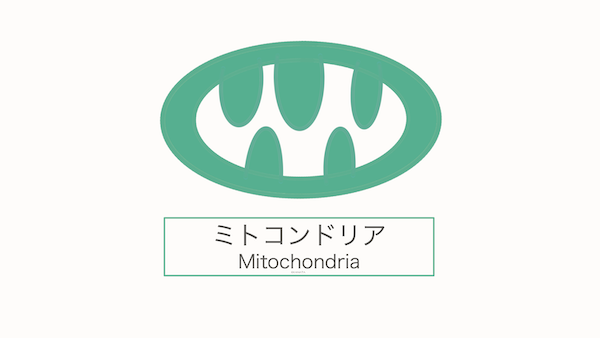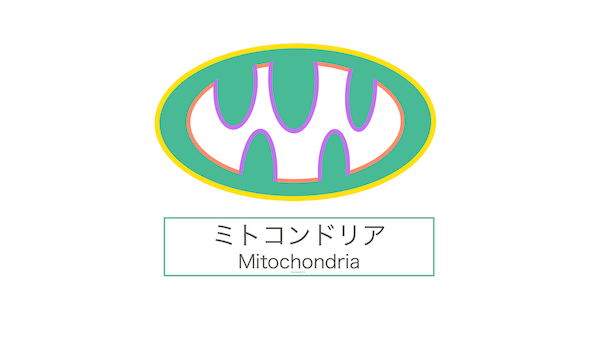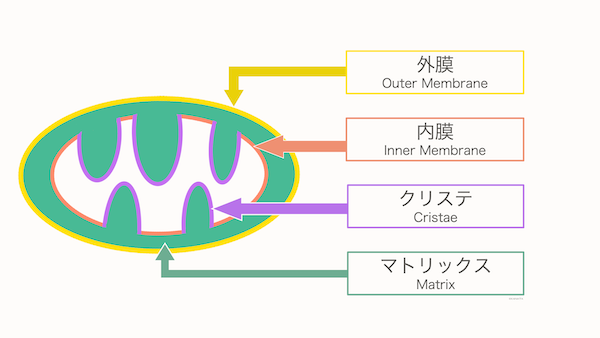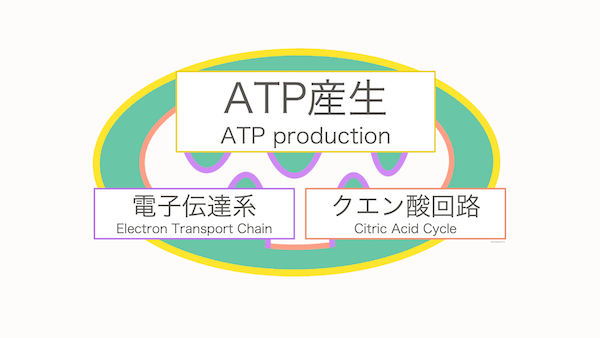Explanation of Mitochondrial Function
Now, in this lecture, we will explain in detail about mitochondria, which we couldn't cover in the previous session.
Please do!
Mitochondria can be considered as a mystery of life.
Really? Is that so?
They are actually a separate organism from us.
A separate organism...
Long ago, even before the existence of humanity, it is said that they started to symbiotically coexist with our ancestors' cells.
Oh, I see.
These mitochondria work unbelievably hard for our sake.
By listening to today's lecture, you will even develop a sense of respect for mitochondria. Pay close attention.
Thank you, I will!

Names of Each Part
Without further ado, before we discuss the functions of mitochondria, I want you to learn the names of each part.
Why is that?
It's to make it easier to visualize where the functions of mitochondria take place.
I see.
There are four locations in mitochondria that you should definitely remember.
Just four?
To make it easier to visualize, I have color-coded the mitochondria.

It's colorful...
Extreme visuals make it easier to understand.

First, you should remember the inner membrane and outer membrane.
In the diagram, they are the yellow and orange parts on the outside and inside.
Outer membrane and inner membrane...
Yes. Next is the part called the matrix.
In the illustration, it is the green area between the outer and inner membranes.
It sounds cool, like a movie title!
You know old movies, huh?
Lastly, there is the cristae, which is formed by the inner membrane protruding.
In the diagram, it is the purple area.
Mitochondria have a lot of unusual names, don't they?
Indeed, they have unique names.
Within this matrix and cristae, they perform important functions such as ATP production, which we will explain later.
So, they are crucial locations.
That's right.

Just remember these four parts.
Yes!
Inner membrane, outer membrane, matrix, cristae
ATP Production
Now, let's explain the functions of mitochondria.
Please do!
First, let's talk about the production of ATP (Adenosine Triphosphate).
ATP?
ATP is the essential energy required for human movement.
Energy...
That's right. It generates the indispensable energy for our body.
ATP is produced in the mitochondria through the processes known as the citric acid cycle (TCA cycle) and the electron transport chain, which are referred to as the "factories" of ATP.

It's important to note that both factories use oxygen to produce ATP.
Yes!
By the way, the two doctors who elucidated this mechanism, Hans Adolf Krebs and Peter Dennis Mitchell, have both received Nobel Prizes.
They are both amazing!
Wow!
The citric acid cycle is also called the Krebs cycle, named after Dr. Krebs, so keep that in mind.
Let's express gratitude to the great predecessors and study hard!
Yes!
It produces energy (ATP) for cellular activities.
Beta-oxidation, lipid metabolism
Next is beta-oxidation. It's a term related to lipid metabolism.
That sounds like a difficult term...
Don't worry. As a cell's assistant, you must have heard of neutral fats, right?
Yes, I have. In fact, I don't like that term much because I've been gaining weight recently.
I see. Did I explain earlier that mitochondria produce ATP, which is the energy for cellular activities?
Beta-oxidation refers to the process of converting lipids, such as neutral fats, to enter the assembly line of the citric acid cycle factory.
I somewhat understand now.
Specifically, beta-oxidation extracts a substance called acetyl-CoA from lipids, but I'll explain the details another day.
For now, just remember that beta-oxidation is the preparatory step for generating energy from fats.
Yes!
It also prepares the production of energy (ATP) from fats.
Urea Cycle - Converting Ammonia into Urea
When you hear the term "ammonia," what kind of image comes to your mind as Cellnosuke?
I think of the smelly substance that's found in urine.
That's correct.
Indeed, ammonia is a substance that is generated during the process of metabolizing the proteins necessary for human survival.
However, ammonia can have harmful effects on the body when it accumulates.
That's why humans convert ammonia into urea and excrete it along with urine.
The mitochondria are responsible for this conversion from ammonia to urea.
The mitochondria are hard workers, aren't they...?
That's right.
They also produce urea (in the urea cycle).
Heme Biosynthesis Pathway
Now, let's move on to the final topic of today's lecture.
Please go ahead!
Do you know why human blood is red?
Is it because our ancestors drank too much tomato juice?
That's definitely not the reason.
The red color of blood is due to red blood cells, which contain iron. It is the iron that binds with oxygen, giving it a red appearance.
Red blood cells! I've heard of them!
That's good to know. Now, within those red blood cells, there is a protein called heme that contains iron.
The mitochondria are responsible for producing this heme.
Mitochondria are truly amazing!
Indeed they are.
They also produce heme (in the heme biosynthesis pathway).
Well, it's been a long lecture, so let's summarize, shall we?
In today's lecture, we covered the four main functions of mitochondria:
- 1. ATP production
- 2. Beta-oxidation
- 3. Urea cycle
- 4. Heme biosynthesis pathway
These topics are often asked in tests, so make sure to remember them well.
Yes!
That concludes today's lecture.
Thank you very much!
Before we finish, let's solve one last problem.
ATP (Adenosine Triphosphate)
TCA cycle (Citric Acid Cycle) and Electron Transport Chain
Beta-oxidation
Urea production (urea cycle) and heme synthesis